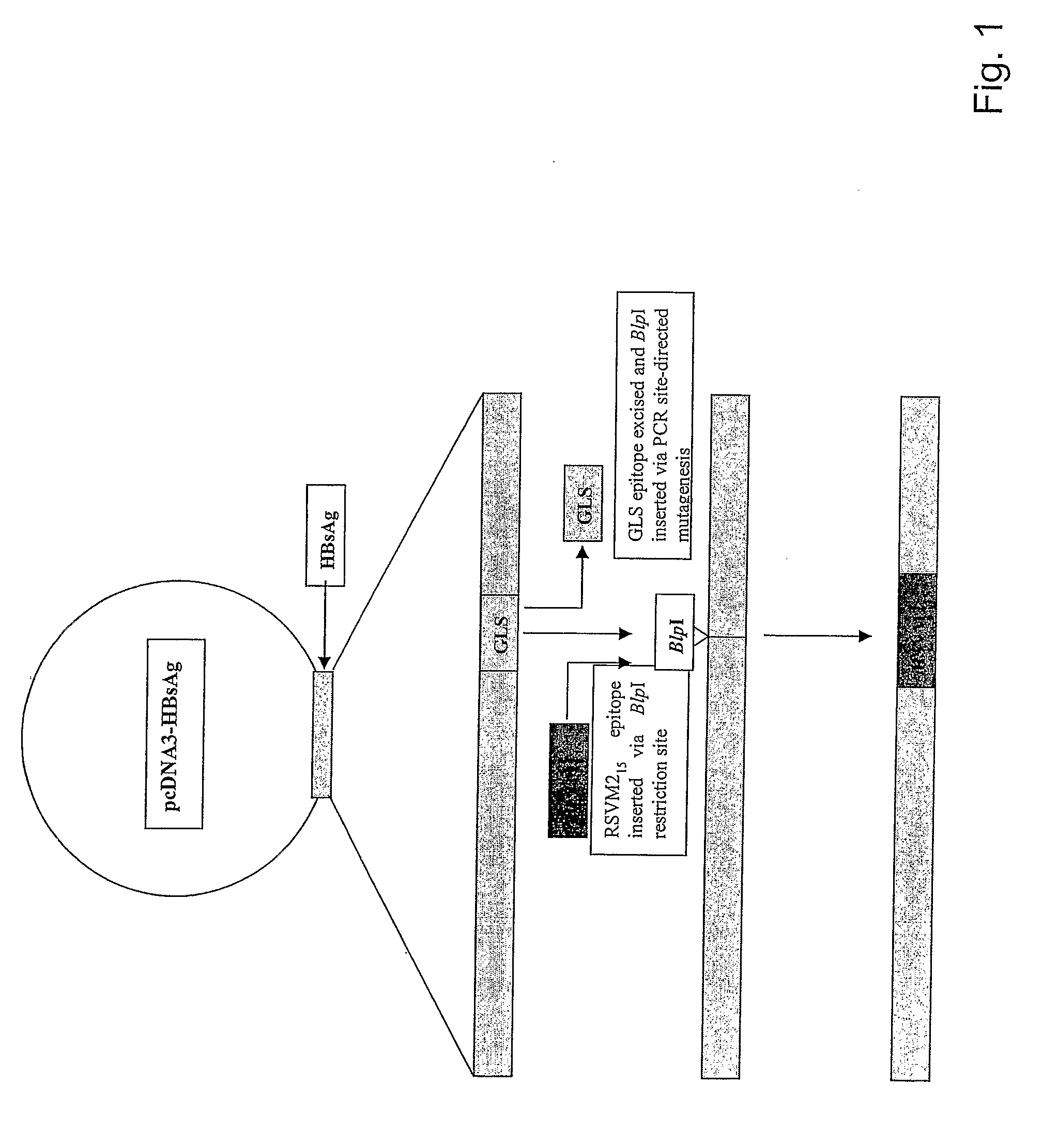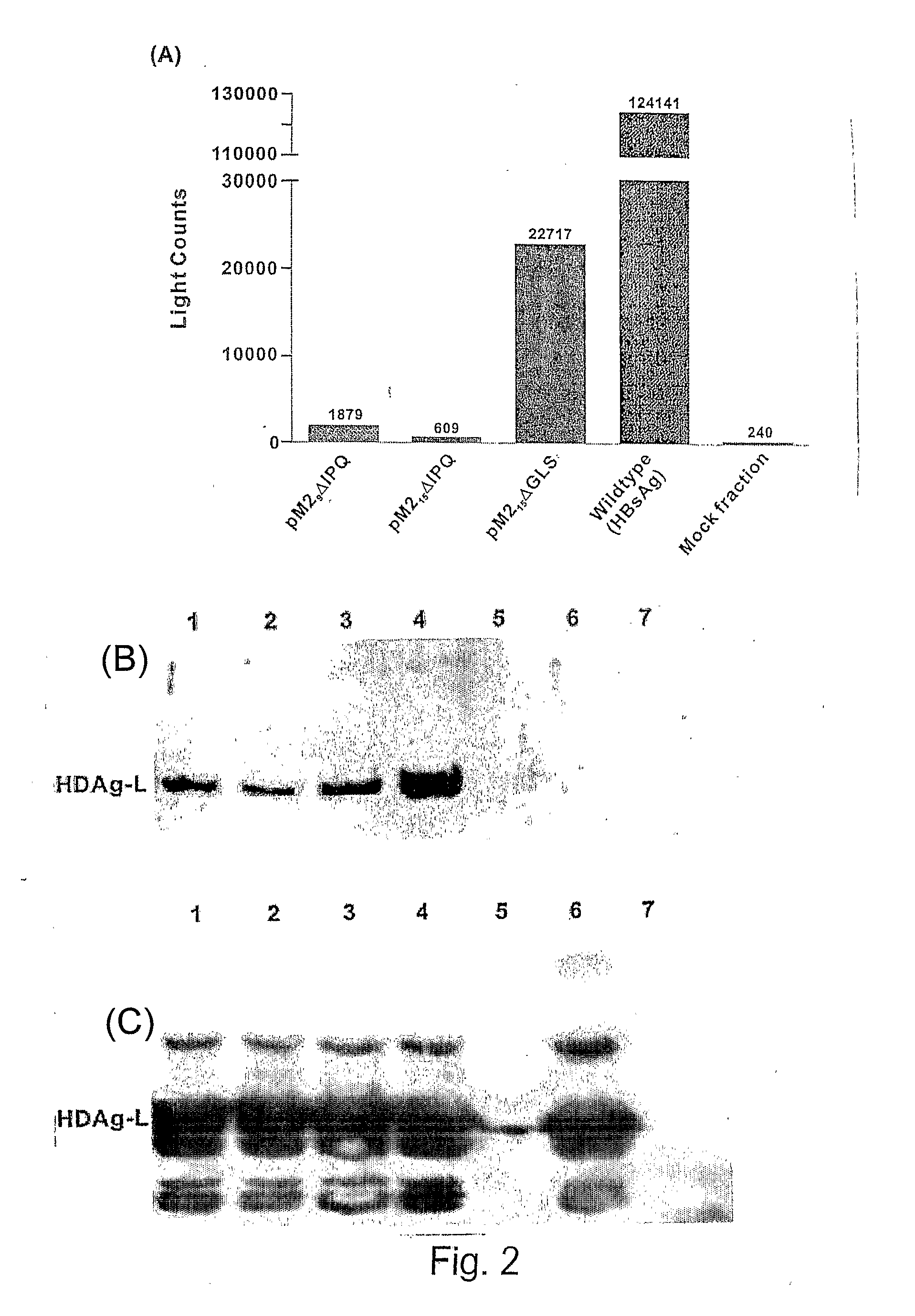Vaccine delivery system
- Summary
- Abstract
- Description
- Claims
- Application Information
AI Technical Summary
Benefits of technology
Problems solved by technology
Method used
Image
Examples
example 1
Materials and Methods
Cloning Procedures
[0187]DNA encoding HBsAg-S was cloned into pcDNA3 (Invitrogen) to derive plasmid pcD3-HBsAgS as described (Netter et al., 2001 J. Virol. 75: 2130-2141). Two intermediate vectors, generically termed pcD3-HBsAgS-Δ‘X’, where Δ‘X’ represents deleted DNA encoding either the IPQ epitope or the GLS epitope of HBsAg (Table 1), were derived from pcD3-HBsAgS by PCR-driven site-directed mutagenesis. The oligonucleotide primers were designed to insert a unique restriction enzyme (RE) site at the site of deletion of the epitope-encoding DNA (NheI at ΔIPQ and BlpI at ΔGLS, respectively) (FIG. 1). A post-PCR DpnI RE digest was carried out to eliminate the original DNA template in the PCR mixture. Plasmid pM215ΔIPQ was derived by insertion of DNA encoding 15 amino acids representing the H-2d-restricted RSV M2 extended epitope (ESYIGSINNITKQSA) at the NheI site of pcD3-HBsAgS-ΔIPQ. The DNA insert was derived by annealing of two corresponding oligonucleotides fo...
example 2
Multicopy Epitopes
[0236]FIG. 10 describes T cell responses to a chimeric HBsAg DNA construct encoding one or multiple copies of a single (tumour) CTL epitope at different sites. At lower effector:target ratio, it appears that RAHx3 and RAHx5 displayed optimal killing and also antigen-specific IFN-γ secretion. The nucleotide and amino acid sequences used in this study are shown in FIG. 19. Data demonstrate that increasing the number of CTL epitopes encoded by HBsAg shows a tendency to increase the magnitude of the CTL response in immunised mice. Preliminary data (not shown) indicates that tumour protection is enhanced also. Factors which are likely to determine outcome include[0237]a single copy may exceed a threshold stimulus for maximal immune activation[0238]Increasing dose of a single copy may be a substitute for multiple copies. Alternatively, a) density of epitope provided by multicopy may be important or b) processing may be limiting ie. 5 copies available from a single site m...
example 3
Effect of Epitope Insertion Site
[0240]FIGS. 11 to 13 describe data obtained from constructs containing protective CTL epitopes from RSV and hMPV which elicits simultaneous CTL responses to both, and thus is a potential vaccine for paediatric respiratory disease in which RSV and hMPV are major pathogens.
[0241]The nucleotide and amino acid sequences used in this study are shown in FIG. 21.
[0242]FIGS. 14 to 17 demonstrate that an epitope inserted at epitope site SIL will elicit CTL responses when that site alone is used for insertion, but will not elicit CTL responses when that site is one among several other sites at which different CTL epitopes are inserted (HG, SIL site).
[0243]Other data have demonstrated that a particular site inserted (M2ΔIPQ) may be immunodominant over a CTL epitope inserted at another site (RAHΔGLS) (See FIG. 8).
[0244]Choice of which endogenous CTL epitope to replace with foreign CTL epitope can be guided by the following principals. I) Be wary of immunodominanc...
PUM
| Property | Measurement | Unit |
|---|---|---|
| Molar density | aaaaa | aaaaa |
| Fraction | aaaaa | aaaaa |
| Fraction | aaaaa | aaaaa |
Abstract
Description
Claims
Application Information
 Login to View More
Login to View More - R&D
- Intellectual Property
- Life Sciences
- Materials
- Tech Scout
- Unparalleled Data Quality
- Higher Quality Content
- 60% Fewer Hallucinations
Browse by: Latest US Patents, China's latest patents, Technical Efficacy Thesaurus, Application Domain, Technology Topic, Popular Technical Reports.
© 2025 PatSnap. All rights reserved.Legal|Privacy policy|Modern Slavery Act Transparency Statement|Sitemap|About US| Contact US: help@patsnap.com



